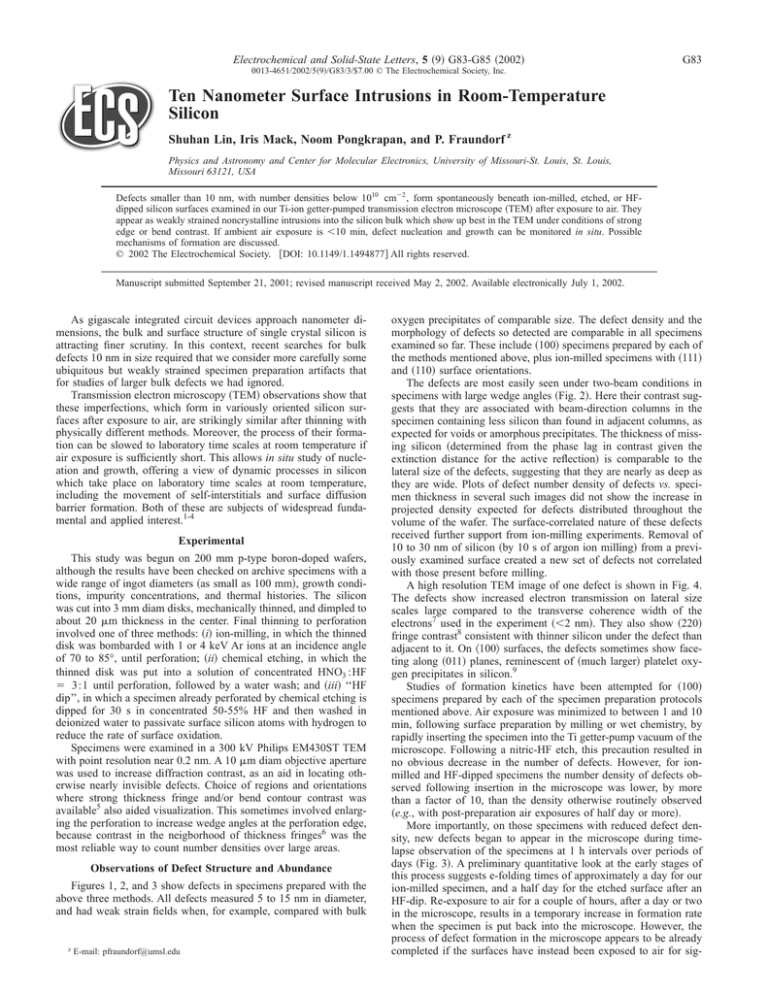
Electrochemical and Solid-State Letters, 5 共9兲 G83-G85 共2002兲
G83
0013-4651/2002/5共9兲/G83/3/$7.00 © The Electrochemical Society, Inc.
Ten Nanometer Surface Intrusions in Room-Temperature
Silicon
Shuhan Lin, Iris Mack, Noom Pongkrapan, and P. Fraundorf z
Physics and Astronomy and Center for Molecular Electronics, University of Missouri-St. Louis, St. Louis,
Missouri 63121, USA
Defects smaller than 10 nm, with number densities below 1010 cm⫺2 , form spontaneously beneath ion-milled, etched, or HFdipped silicon surfaces examined in our Ti-ion getter-pumped transmission electron microscope 共TEM兲 after exposure to air. They
appear as weakly strained noncrystalline intrusions into the silicon bulk which show up best in the TEM under conditions of strong
edge or bend contrast. If ambient air exposure is ⬍10 min, defect nucleation and growth can be monitored in situ. Possible
mechanisms of formation are discussed.
© 2002 The Electrochemical Society. 关DOI: 10.1149/1.1494877兴 All rights reserved.
Manuscript submitted September 21, 2001; revised manuscript received May 2, 2002. Available electronically July 1, 2002.
As gigascale integrated circuit devices approach nanometer dimensions, the bulk and surface structure of single crystal silicon is
attracting finer scrutiny. In this context, recent searches for bulk
defects 10 nm in size required that we consider more carefully some
ubiquitous but weakly strained specimen preparation artifacts that
for studies of larger bulk defects we had ignored.
Transmission electron microscopy 共TEM兲 observations show that
these imperfections, which form in variously oriented silicon surfaces after exposure to air, are strikingly similar after thinning with
physically different methods. Moreover, the process of their formation can be slowed to laboratory time scales at room temperature if
air exposure is sufficiently short. This allows in situ study of nucleation and growth, offering a view of dynamic processes in silicon
which take place on laboratory time scales at room temperature,
including the movement of self-interstitials and surface diffusion
barrier formation. Both of these are subjects of widespread fundamental and applied interest.1-4
Experimental
This study was begun on 200 mm p-type boron-doped wafers,
although the results have been checked on archive specimens with a
wide range of ingot diameters 共as small as 100 mm兲, growth conditions, impurity concentrations, and thermal histories. The silicon
was cut into 3 mm diam disks, mechanically thinned, and dimpled to
about 20 m thickness in the center. Final thinning to perforation
involved one of three methods: 共i兲 ion-milling, in which the thinned
disk was bombarded with 1 or 4 keV Ar ions at an incidence angle
of 70 to 85°, until perforation; 共ii兲 chemical etching, in which the
thinned disk was put into a solution of concentrated HNO3 :HF
⫽ 3:1 until perforation, followed by a water wash; and 共iii兲 ‘‘HF
dip’’, in which a specimen already perforated by chemical etching is
dipped for 30 s in concentrated 50-55% HF and then washed in
deionized water to passivate surface silicon atoms with hydrogen to
reduce the rate of surface oxidation.
Specimens were examined in a 300 kV Philips EM430ST TEM
with point resolution near 0.2 nm. A 10 m diam objective aperture
was used to increase diffraction contrast, as an aid in locating otherwise nearly invisible defects. Choice of regions and orientations
where strong thickness fringe and/or bend contour contrast was
available5 also aided visualization. This sometimes involved enlarging the perforation to increase wedge angles at the perforation edge,
because contrast in the neigborhood of thickness fringes6 was the
most reliable way to count number densities over large areas.
Observations of Defect Structure and Abundance
Figures 1, 2, and 3 show defects in specimens prepared with the
above three methods. All defects measured 5 to 15 nm in diameter,
and had weak strain fields when, for example, compared with bulk
z
E-mail: pfraundorf@umsl.edu
oxygen precipitates of comparable size. The defect density and the
morphology of defects so detected are comparable in all specimens
examined so far. These include 共100兲 specimens prepared by each of
the methods mentioned above, plus ion-milled specimens with 共111兲
and 共110兲 surface orientations.
The defects are most easily seen under two-beam conditions in
specimens with large wedge angles 共Fig. 2兲. Here their contrast suggests that they are associated with beam-direction columns in the
specimen containing less silicon than found in adjacent columns, as
expected for voids or amorphous precipitates. The thickness of missing silicon 共determined from the phase lag in contrast given the
extinction distance for the active reflection兲 is comparable to the
lateral size of the defects, suggesting that they are nearly as deep as
they are wide. Plots of defect number density of defects vs. specimen thickness in several such images did not show the increase in
projected density expected for defects distributed throughout the
volume of the wafer. The surface-correlated nature of these defects
received further support from ion-milling experiments. Removal of
10 to 30 nm of silicon 共by 10 s of argon ion milling兲 from a previously examined surface created a new set of defects not correlated
with those present before milling.
A high resolution TEM image of one defect is shown in Fig. 4.
The defects show increased electron transmission on lateral size
scales large compared to the transverse coherence width of the
electrons7 used in the experiment 共⬍2 nm兲. They also show 共220兲
fringe contrast8 consistent with thinner silicon under the defect than
adjacent to it. On 具100典 surfaces, the defects sometimes show faceting along 共011兲 planes, reminescent of 共much larger兲 platelet oxygen precipitates in silicon.9
Studies of formation kinetics have been attempted for 共100兲
specimens prepared by each of the specimen preparation protocols
mentioned above. Air exposure was minimized to between 1 and 10
min, following surface preparation by milling or wet chemistry, by
rapidly inserting the specimen into the Ti getter-pump vacuum of the
microscope. Following a nitric-HF etch, this precaution resulted in
no obvious decrease in the number of defects. However, for ionmilled and HF-dipped specimens the number density of defects observed following insertion in the microscope was lower, by more
than a factor of 10, than the density otherwise routinely observed
共e.g., with post-preparation air exposures of half day or more兲.
More importantly, on those specimens with reduced defect density, new defects began to appear in the microscope during timelapse observation of the specimens at 1 h intervals over periods of
days 共Fig. 3兲. A preliminary quantitative look at the early stages of
this process suggests e-folding times of approximately a day for our
ion-milled specimen, and a half day for the etched surface after an
HF-dip. Re-exposure to air for a couple of hours, after a day or two
in the microscope, results in a temporary increase in formation rate
when the specimen is put back into the microscope. However, the
process of defect formation in the microscope appears to be already
completed if the surfaces have instead been exposed to air for sig-
G84
Electrochemical and Solid-State Letters, 5 共9兲 G83-G85 共2002兲
Figure 1. Defects which formed spontaneously when a silicon 共111兲 specimen was given less than 5 min of air exposure after being thinned by argon
ion milling. The gray value histogram of the image has been equalized to
improve defect visibility.
nificantly longer periods of time 共e.g., a day or more兲 before examination.
We have been unable to induce formation of these defects by
exposure to the electron beam, even at beam intensities which are
orders of magnitude higher than those used for routine observation.
High-resolution studies of these defects during the time series on
HF-dipped specimens confirm our impression, from conventional
TEM images, that the defects reach nearly their final size by first
glance, i.e., on time scales short compared to 1 h.
Hence the formation of the defects seems, under these conditions, to be limited by rate of nucleation and not by rate of growth.
Figure 3. Images taken 1 and 45 h after a 5 min air exposure of silicon 共100兲
etched in 3:1 HNO3 :HF and then dipped in concentrated HF to retard the
rate of oxidation. We have detailed chronology on the formation time of all
defects in the after image, except for those circled. These were formed in an
interval between the 31 and the 45 h mark, when no intervening observations
were made.
The initial rate of nucleation, in turn, may be limited by the surface
concentration of a molecular species available through exposure to
air 共like oxygen兲. Time-lapse series, and video tapes, over shorter
time intervals should allow a look at the growth process itself. Given
the apparent insensitivity of the process to electron examination,
such series may also allow lattice-scale prenucleation imaging of
sites at which defects are destined to develop at a later time.
Discussion
Figure 2. Defects seen with help from thickness fringe contrast under 共220兲
two-beam near-Bragg conditions in silicon 共001兲 after a 3:1 HNO3 :HF acid
etch. Defect density and specimen thickness are not proportional. The wedge
half-angle is ⬃12°.
The classic empirical test for artifacts of TEM specimen preparation is simple. Thin the specimen by two physically different techniques, e.g., by both Ar ion-milling and by chemical etching. Only
defects that are not a result of specimen preparation are likely to be
common in both cases. This test was the inspiration for work on
etched specimens, after we began characterizing more carefully the
defects in Ar ion-milled silicon mentioned above. Even though the
literature10 argued against argon bubbles as a possible source, given
our high incidence angles and relatively large defect sizes, we
wanted experimental confirmation.
The defects pass the classical test, in that they are ubiquitous in
etched and ion-milled surfaces of many orientations and vintage
共some stored in air after perforation for more than twenty years兲.
Work here, however, shows that they do form after specimen preparation. In that sense, literature studies of bulk defects have appropriately ignored them. The presence of comparable defect number densities, sizes, and, in the case of ion milled and HF-dipped specimens,
comparable formation dynamics, after physically diverse thinning
processes thus argues that they result from the interaction between
fresh silicon surfaces and air or the microscope vacuum, independent of the way in which the surfaces are created.
Electrochemical and Solid-State Letters, 5 共9兲 G83-G85 共2002兲
G85
Figure 5. Image of crystalline defects with comparably weak strain fields,
small sizes, and high number densities likely formed after thinning silicon
共100兲.
Figure 4. A HREM image of spontaneously forming defects in an
HNO3 :HF etched silicon 共100兲 specimen. Faceting parallel to the 0.192 nm
共022兲 fringes is atypically strong in this defect.
Observed parameters are as follows: 共i兲 Final defect number densities, after extended air exposure at standard temperature and pressure are ⬃1010 defects/cm2 ; 共ii兲 Initial exponential-fit characteristic
共e-folding兲 times for nucleation, independent of air exposure, are in
the 10-30 h range; 共iii兲 Final size of defects is ⬃10 nm, sometimes
trailing to smaller and less visible sizes; 共iv兲 Time elapsed between
nucleation, and growth to full size, is much less than 1 h.
Why these values? Note that 1010 defects/cm2 corresponds to an
average half-distance between defects of around 50 nm. This is comparable to the distance for strain field relaxation in silicon.11 The
defects might thus support a process of silicon surface hardening on
air exposure, in which a compressional strain field 共still mild compared to that of oxygen precipitates in a wafer interior兲 is built up
around an array of defects due to oxidation. Oxidation of silicon
surfaces occurs at room temperature by indiffusion that can leave
atomic steps on the surface statistically intact. Hence significant
expansion likely takes place at the buried oxide/silicon interface.
The resulting strain field, much like the reaction skin on a pot of
soup allowed to sit, could in turn limit further defect formation and
defect size. One consequence of this mechanism would be an expected decrease in size of intrusions near one another, something not
demonstated so far.
The presence of such subsurface defects will have consequences.
Even buried beneath the native oxide, they will scatter light diffusely. Harada et al.12 report scanning probe microscope observation of hillocks on Si共100兲 that assist early stage oxidation, with
lateral sizes and number densities comparable to the defects reported
here. Silicon’s volume increase on oxidation may thus result in associated surface hillocks. This is supported so far by preliminary
work in our lab at creating such defects on extremely flat 共as evidenced by 0.13 nm steps after native oxidation兲 epitaxial silicon. We
now think that previously reported crystalline defects in TEM specimens of ‘‘bulk’’ silicon 共Fig. 5兲 with comparable number densities
and a 2% lattice misfit13 may also have formed at specimen surfaces
after thinning. Recent HREM work on similarities between the
above crystalline defects and Cu3 Si colony defects14 in bulk silicon,
and the similarity of intrusions reported here to S-pit intrusions associated with nickel contamination15 in Si, suggest that heterogeneous nucleation may play a role in determining the number density
of these defects as well.
Acknowledgments
Thanks to Lu Fei, Jeff Libbert, Lucio Mulestagno, and Blake
Rowe at MEMC Electronic Materials for insight and diverse specimens, and to MEMC, Monsanto, and Boeing for regional facility
support.
The University of Missouri-St. Louis assisted in meeting the publication
costs of this article.
References
1.
2.
3.
4.
5.
6.
7.
8.
9.
10.
11.
12.
13.
14.
15.
M. J. Aziz, Appl. Phys. Lett., 70, 2810 共1997兲.
R. C. Newman, J. Phys.: Condens. Matter, 12, R335 共2000兲.
S. M. Myers, M. Seibt, and W. Schroter, J. Appl. Phys., 88, 3795 共2000兲.
S. K. Estreicher, M. Gharaibeh, P. A. Fedders, and P. Ordejon, Phys. Rev. Lett., 86,
1247 共2001兲.
P. Hirsch, A. Howie, R. B. Nicholson, D. W. Pashley, and M. J. Whelan, Electron
Microscopy of Thin Crystals, 2nd ed., Robert E. Krieger Publishing Company,
Malabar, FL 共1977兲.
M. F. Ashby and L. M. Brown, Philos. Mag., 8, 1649 共1963兲.
J. C. H. Spence, Experimental High-Resolution Electron Microscopy, 2nd ed., Oxford University Press, New York 共1988兲.
J. G. Allpress and J. V. Sanders, J. Appl. Crystallogr., 6, 165 共1973兲.
T. Y. Tan and W. K. Tice, Philos. Mag., 34, 615 共1976兲.
U. Bangert, P. J. Goodhew, C. Jeynes, and I. H. Wilson, J. Phys. D: Appl. Phys., 19,
589 共1986兲.
M. F. Ashby and L. M. Brown, Philos. Mag., 8, 1083 共1963兲.
Y. Harada, M. Niwa, T. Nagatomi, and R. Shimizu, Jpn. J. Appl. Phys., Part 1, 39,
560 共2000兲.
P. Fraundorf and G. K. Fraundorf, in Proceedings of the 47th Annual Electron
Microscope Society of America Meeting, G. W. Bailey, Editor, p. 122, San Francisco Press 共1989兲.
J. K. Solberg, Acta Crystallogr., Sect. A: Cryst. Phys., Diffr., Theor. Gen. Crystallogr., 34, 684 共1978兲.
G. Keefe-Fraundorf and R. A. Craven, Abstract 308, p. 480, The Electrochemical
Society Extended Abstracts, Vol. 83-1, San Francisco, CA, May 8-13, 1983.




